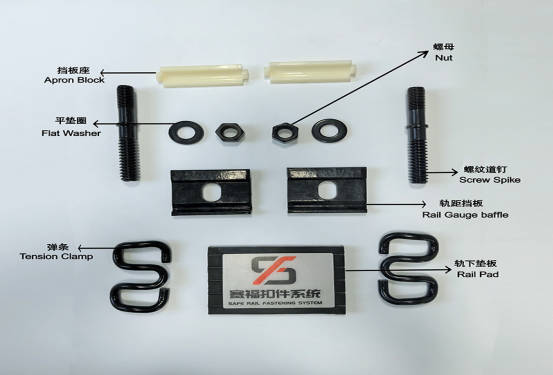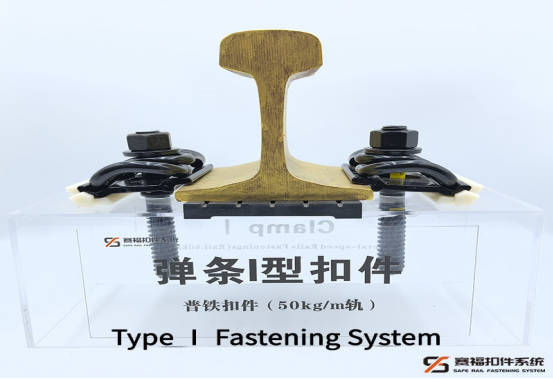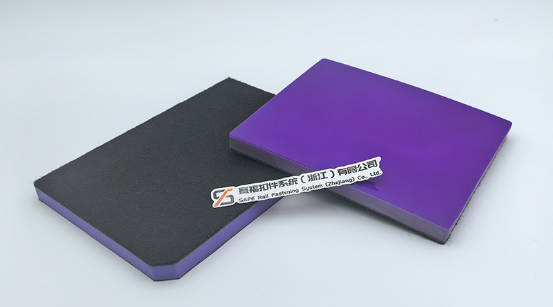
What is a Type I Fastening System
Fastening systems play an important role in ensuring rail safety. Without guaranteed fastenings, rails will move, leading to derailment and fatal accidents.Type I fastening system is a key element that firmly secures rails to sleepers (railroad ties), which provide the basis of safe and secure rail tracks. It ensures proper rail gauge, spreads loads from moving trains, and also offers the required flexibility for high-speed runs. They limit rail motion during dynamic loads, reduce vibrations, are sound-absorbing, and provide effective electrical insulation for signalling devices. SAFE’s Type I is an all-purpose system ideal for concrete sleepers for ballasted tracks. It integrates various components to provide long-life, flexible, and safe rail bonding, which satisfies international requirements like the EN 13481 series.
Type I Fastening System Major Components
Four significant Type I fastening system components interact to secure rails, reduce vibration, and support track geometry.
| Component | Function | Key Benefit |
|---|---|---|
| Elastic Clip | Clamps the rail to the sleeper | Maintains consistent clamping force |
| Rail Pad | Cushions between rail and sleeper | Reduces vibration and wear, improves passenger comfort |
| Anchor Bolt | Secures the assembly to the sleeper | Transfers vertical and lateral forces for track stability |
| Insulator | Electrically isolates rails | Ensures proper signaling system operation |
Elastic Clips: These clips, for example, W-tension clamps, E-clips, or Fast Clips, prevent rail foot loosening. They preserve clamping force throughout their working life, retaining the rail under heavy load.
Rail Pads: Resilient materials are used in the production of rail pads, which take up dynamic loads, suppress vibration, and offer sleeper wear protection. Quality pads also include electrical insulation, safeguarding signaling systems.
Anchor Bolts: Anchor bolts hold the assembly onto concrete sleepers, transferring safely mechanical loads to the track structure. Anchor bolts possess high tensile and shear strength along with long-term stability.
Insulators: Rail gauge insulators prevent electrical current from flowing between rails. They offer mechanical support with insulation, which is essential for current electronic train control systems.

How the Type I Fastening System Works
Type I fastening system utilizes mechanical load spreading and clamping to secure the rails:
- Fixing the Rail: Elastic clips press down on the rail foot while rail pads spread the load on the sleeper surface. Forces are transferred to the concrete sleeper through anchor bolts.
- Damping of Vibration and Noise: Elastic clips and rail pads deform under dynamic loading, dissipating energy and reducing noise. Rubber boots and customized rubber pads may be designed for improving vibration control.
- Rigidity of Track Geometry: The system affords resistance against movement of the rail while providing controlled flexibility to ensure correct gauge, cant, and alignment. This ensures long-term track stability under varied loads.
Benefits of the SAFE Type I Fastening System
- Reliability and Durability: High-grade steel and polymer components, accurate manufacturing, and stringent testing guarantee reliable performance.
- Simple Installation: Normalized components make assembly easy using ordinary tools, minimizing labor and installation time.
- Flexibility: It is suitable for a wide range of rail profiles, sleeper types, and track configurations, making it suitable for most applications.
- Noise and Vibration Reduction: Elastic elements and rail pads absorb vibration and sound, lowering noise and thus improving passenger comfort for city transit systems.
Applications in Railway Infrastructure
High-speed railways
Applications of high-speed lines in railways require increased precision and reliability. In Morocco Kenitra-Marrakech High-Speed Railway Project, our company, in 2025, with our end-to-end quality assurance process and precision manufacturing, supplied our fastening systems, which have operated successfully in challenging high-speed conditions, delivering track stability at running speeds over 300 km/h.
Heavy-haul freight lines
Heavy-haul utilizes fastening systems that can sustain extreme loadings and high-frequency traffic. In 2023 Fenghong and Jingshen Railway project, we delivered 130,000 sets of heavy-haul railway high-performance fastening systems to Shaanxi. Our systems under such stressful conditions show better performance, guaranteeing safe operation for key freight routes.
Urban transit systems
Urban transit systems benefit from our noise reduction features and maintenance efficiency. In 2020 Chengdu Metro Line 17 Project, as a strategic partner to Chengdu Metro Line 17—a west China hub—we designed a next-generation solution. Our solutions meet the unique demands of urban areas, including noise control and space constraints.
Compliance and Quality Standards
Type I fastening systems adhere to EN 13481 series standards and other global railway standards. Parts are tested stringently under real traffic conditions to ensure long-term reliability. The use of strong materials, heat-treated steel parts, and chemical-resistant polymers ensures prolonged life even under extremely harsh environmental conditions.

Conclusion
The Type I railroad fastening system is a vital element of rail track stability, passenger safety, and long-term infrastructure reliability. By utilizing elastic clips, rail pads, anchor bolts, and insulators, it successfully fastens the rails, dampens vibrations, ensures geometry, and can accommodate various types of tracks. For railroad operators, utilizing high-quality Type I systems improves safety, minimizes maintenance, and can accommodate various types of rail applications.
FAQ
Q: What is the anticipated life of Type I fastening systems?
A: Our Type I systems will yield 25-30 years of life under regular operating conditions, with some components surviving longer than others, but with periodic maintenance.
Q: Are Type I systems offered for retrofitting installed tracks?
A: Yes, our Type I systems are compatible with traditional concrete sleeper installations, so retrofitting is fairly straightforward in most cases.
Q: How much maintenance do Type I fastening systems need?
A: Regular visual check and regular torque verification are the main requirements. Our systems are made for minimal maintenance but guarantee long-term dependability.
Q: Why are SAFE Type I systems better than others?
A: Our systems provide better materials, rigorous testing, and established performance in an immense variety of tasks all over the world, with the advantage of significant years of manufacturing experience and constant innovation.




